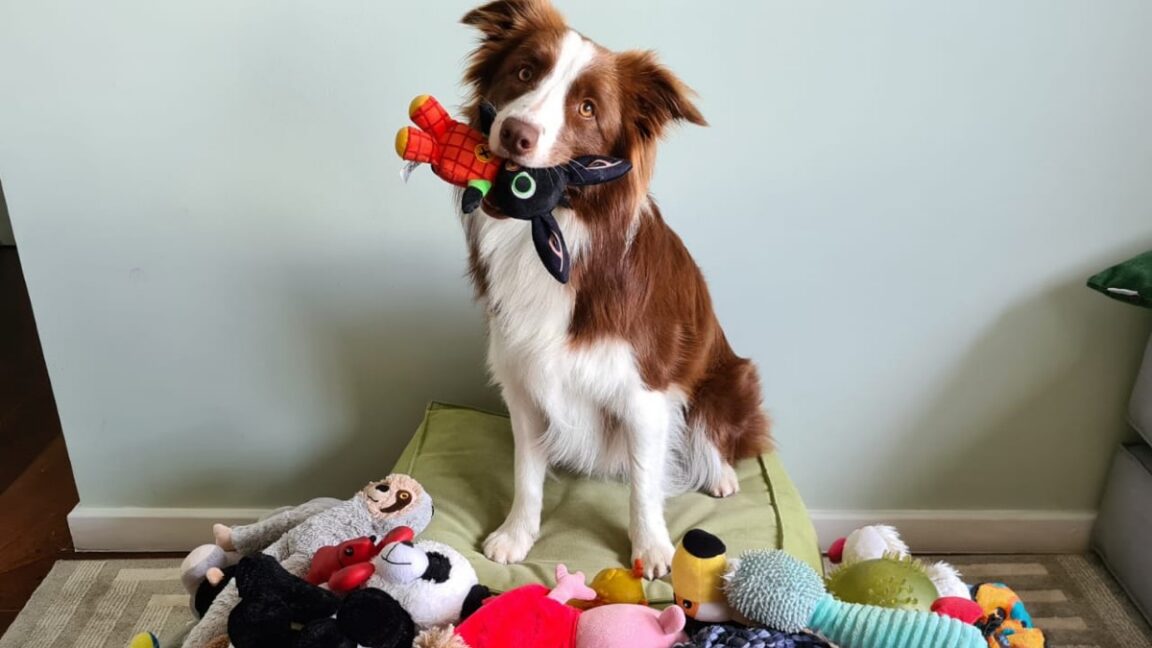Science
Dogs Demonstrate Advanced Toy Classification Skills Without Training

Recent research reveals that certain dogs possess the remarkable ability to classify their toys not just by appearance but by function. According to a study published in the journal Current Biology, these dogs can extend their understanding of labels to new objects based on their functionality, a skill usually requiring extensive training.
The study, led by Claudia Fugazza from Eötvös Loránd University in Budapest, Hungary, highlights a cognitive ability known as “label extension.” This process allows dogs to categorize items in a way akin to humans learning that a “cup” can refer to various types of containers, such as mugs or tumblers. Fugazza explains, “The rock and the hammer look physically different, but they can be used for the same function. So now it turns out that these dogs can do the same.”
The research examined seven dogs, all classified as “gifted word learners,” including six Border Collies and one Blue Heeler, who had already shown a capacity for learning the names of numerous toys through casual play. The team focused on whether these dogs could apply their understanding of labels to new toys that served similar play functions, such as “pull” or “fetch.”
In the initial phase, the dogs learned to associate the terms “pull” and “fetch” with a diverse range of toys. Owners played with the dogs using these toys while consistently using the correct labels. Subsequently, the dogs were introduced to new, unlabeled toys in a natural play setting, where they were encouraged to engage in pulling or fetching activities without verbal prompts.
Fugazza noted the simplicity of the setup: “For these new toys, they’ve never heard the name, but they have played either pull or fetch, and so the dog has to choose which toy was used to play which game. This was done in a natural setup, with no extensive training.”
The results proved significant. The dogs demonstrated a statistically significant ability to select the correct unlabeled toys based on their prior experiences with similar functions. “We have shown that dogs learn object labels really fast, and they remember them for a long period, even without rehearsing,” Fugazza stated.
This innovative study builds on previous research conducted by the same team, which explored how dogs interpret gestures and the factors influencing their spatial awareness. In a 2023 report, the researchers found that dogs interpret pointing as a directional cue, differing from human toddlers who focus more on the object itself. This distinction highlights how canine cognition may mirror certain aspects of human thought processes, particularly among more intelligent breeds.
The research also explored the relationship between a dog’s head structure and visual acuity, with findings indicating that dogs with shorter heads tend to have better visual capabilities. This anatomical trait correlates with a greater concentration of retinal ganglion cells, enhancing depth perception and overall visual sharpness.
In addition to their visual skills, dogs were shown to utilize a combination of sensory input when locating toys. Earlier findings from 2022 demonstrated that dogs could remember key sensory features of their toys, such as appearance and scent, when tasked with identifying named toys. Despite their superior olfactory capabilities, dogs primarily relied on visual cues in both light and dark conditions. Interestingly, they exhibited increased sniffing behavior when visibility was limited, suggesting that they adapt their strategies based on environmental factors.
The implications of this research extend beyond canine capabilities. Understanding how dogs process and categorize information may provide insights into cognitive functions in other species, including humans. The precise mechanisms underlying this label extension ability remain to be fully understood, paving the way for future studies into the cognitive and language-related skills of dogs and other animals.
As the field of animal cognition continues to evolve, this study stands out as a testament to the intricate capabilities of dogs, showcasing their potential to learn and adapt in ways previously thought to be exclusive to humans.
-

 World3 months ago
World3 months agoScientists Unearth Ancient Antarctic Ice to Unlock Climate Secrets
-

 Entertainment3 months ago
Entertainment3 months agoTrump and McCormick to Announce $70 Billion Energy Investments
-

 Science3 months ago
Science3 months agoFour Astronauts Return to Earth After International Space Station Mission
-

 Lifestyle3 months ago
Lifestyle3 months agoTransLink Launches Food Truck Program to Boost Revenue in Vancouver
-

 Technology2 months ago
Technology2 months agoApple Notes Enhances Functionality with Markdown Support in macOS 26
-

 Top Stories1 week ago
Top Stories1 week agoUrgent Update: Fatal Crash on Highway 99 Claims Life of Pitt Meadows Man
-

 Sports3 months ago
Sports3 months agoSearch Underway for Missing Hunter Amid Hokkaido Bear Emergency
-

 Politics2 months ago
Politics2 months agoUkrainian Tennis Star Elina Svitolina Faces Death Threats Online
-

 Technology3 months ago
Technology3 months agoFrosthaven Launches Early Access on July 31, 2025
-

 Politics3 months ago
Politics3 months agoCarney Engages First Nations Leaders at Development Law Summit
-

 Entertainment3 months ago
Entertainment3 months agoCalgary Theatre Troupe Revives Magic at Winnipeg Fringe Festival
-

 Politics1 week ago
Politics1 week agoShutdown Reflects Democratic Struggles Amid Economic Concerns




















